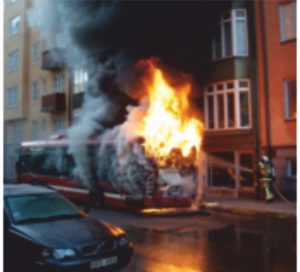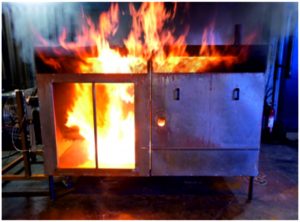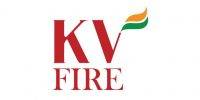Bus transportation is regarded as one of the safest modes of public transportation and millions of passengers ride safely every day to and from work, school and for pleasure. The manufacturers and operators of buses have done some work in this area but more can be done. However, a fire resulting from a collision or failure of a component puts lives at risk and will impact on operational costs as well as on customer confidence. SP Technical Research Institute of Sweden (SP) has conducted a lot of research in the area of fire safety of buses. One part has been to develop a new international standard for fire suppression systems installed in bus engine compartments.
Background
Fires in buses are common and buses are daily involved in fire incidents. For instance, in the US approximately six school bus fires are reported every day. Recent statistics from Sweden show that at least 0.76 percent of all buses in service annually will suffer from an incident with fire or smoke. This is confirmed by surveys made in Germany where between 0.5 and 1 percent of all buses suffer from a fire incident every year which corresponds to at least 350 – 400 fires annually. From time to time bus fires result in numerous fatalities. An example is a fire in October 2015 in Puisseguin, France, where a bus crashed into a truck, causing the two vehicles to burn and the death of 43 people. Luckily most fire incidents do not lead to fatalities, but the property loss and the cost due to business discontinuity, rescue operation and traffic jam can be extensive.
Aircraft, trains and passenger ships all have well established standards, regulations and certification processes to ensure the maintenance of high levels of safety as new materials and constructions are introduced. Buses on the other hand, mostly rely on the efforts of the OEMs, operators and suppliers of fire systems to ensure safety with few strict regulations.
Fire suppression systems installed in engine compartments
About 2/3 of all bus fires start in the engine compartments of the buses. The engine compartment is a well-known fire hazard that provides particular challenges for detection and suppression of fires. Ventilation, through fans and openings is necessary for cooling but will also increase fire intensity and fire spread, see figure 1. The particularity of a windy and often dusty environment in the engine compartment influences the possibility for fire detection and fire suppression. This has naturally led to efforts of reducing the fire risks of bus engine compartments. A way of increasing the fire protection, which has become more and more common, is to install an automatic fire suppression system in the engine compartment. Such systems consist of one or more containers of suppression agent and a fire detection and activation system that releases the suppression agent in the event of fire. A piping or tubing system is often used for the distribution of the suppression agent from the container to the different areas of the engine bay. Some systems, e.g. with aerosol generators, often have generators installed in the engine room and releases the agent directly from the generator. In addition to suppressing the fire, the systems are normally also designed to warn the bus driver through an alarm in case of fire. Various types of suppression agents are used including different sorts of dry chemical, water mist, foam, aerosol, gaseous agents or sometimes combinations of those.
The installation of automatic fire detection and suppression system for buses has been recommended by fire researchers, trade associations, accident investigators and transport authorities. It is generally not perceived as the ultimate solution on the bus fire problem, but as one of several tools necessary to limit the extent and the consequences of bus fires occurring in society.
 Figure 1: Bus fires a common issue worldwide. (Photo: The Greater Stockholm Fire Brigade – Niklas Nordenskär)
Figure 1: Bus fires a common issue worldwide. (Photo: The Greater Stockholm Fire Brigade – Niklas Nordenskär)
Fire suppression systems for buses have traditionally been tested and verified according to general standards for suppression systems with different test protocols depending on the agent used. This has made it difficult to compare the suppression performance of different types of agents and systems with a combination of agents have not always been able to approve as a whole. The tests have not either taken into account the specific challenges with the application, in this case engine compartments of buses.
An approach to validate suppression system performance with focus on the application has been to carry out fire suppression tests in the engine compartment of a bus. This type of testing has been used e.g. by bus manufacturers to evaluate different suppression system solutions. One example of such test procedure is described in the standard SBF 128 published by the Swedish Fire Protection Association. The test is performed while the engine is on idle and the fire load, mainly consisting of sawdust soaked in diesel and gasoline, are being spread in the engine compartment, ignited and allowed to burn for 20 seconds before activation of the fire suppression system. A passed test approves the system for installation in any type of bus given that it also fulfils a set of other requirements, for example a fixed minimum amount of suppression agent depending on the agent type. This has been required by Swedish insurance companies in their request for fire suppression systems on all insured buses since 2004. However, in a forthcoming edition (SBF 128:3) the engine compartment suppression test is planned to be replaced from 2017 by SP method 4912, see further on in this article.
During recent years, some major research initiatives have been taken to develop standardized tests for engine compartment fires. Southwest Research Institute was contracted by The National Highway Traffic Safety Administration (NHTSA) in the USA to develop test apparatuses and test procedures to evaluate candidate fire detection and suppression systems for motorcoach engine compartments. FM Global’s Research Division has developed FM Approval Standard 5970 Protection Systems for Heavy Duty Mobile Equipment. Though focusing on heavy duty equipment rather than buses, the applications have much in common and thus worth mentioning here.
Development of a new test method for fire suppression systems installed in bus engine compartments
Despite the growing demand for fire suppression systems for buses and recent year’s research efforts there were previously no existing international standards for testing and validating such systems. Based on earlier research on bus fire safety, SP initiated a project in 2010, supported by the Swedish Transport Agency, with the purpose of developing a test standard for evaluating automatic fire suppression systems meant for bus engine compartments. The purpose was to design a standardized test setup which allows systems with any type of suppression agent or combination of agents to be tested against the same fire hazards under realistic conditions and thus facilitate comparison of the performance of different agents and suppression system solutions. The main goal was to develop a test method that possibly could be implemented in the UNECE Regulation No 107. In cooperation with a worldwide reference group a comprehensive work started which included both theoretical and practical studies. Different models of buses were reviewed, paying special attention to their aerodynamic, geometrical and thermodynamic aspects, as well as the properties of the flammable materials contained in these compartments. Full scale fire tests were also conducted using commercial buses with operating engines and more than 450 laboratory fire suppression tests were performed with different suppression system types in order to develop the test methodology. Under its development, careful attention was paid to the identification of test conditions which would represent realistic fire scenarios. This work led to the established test method SP Method 4912, Method for testing the suppression performance of fire suppression systems installed in engine compartments of buses and coaches.
 Figure 2: Fire suppression testing according to the described method. A fan is seen to the left. (Photo: SP Fire Research)
Figure 2: Fire suppression testing according to the described method. A fan is seen to the left. (Photo: SP Fire Research)
The fire suppression tests are performed in a test apparatus which is a full scale engine compartment mock-up with obstructions, aiming to represent generally cluttered engine compartment interior. The external gross volume of the test rig is 4 m³. Figure 2 shows a fire test according to the test method.
The method includes eleven different suppression tests which differ from each other with respect to fire source type, severity and location, grade of obstruction and number of the fire sources used, as well as air flow rate applied.
The test report of the conducted tests rates the tested suppression system based on the number of passed (extinguished) tests and the ability to protect against hot surface re-ignition. This means that manufacturers can compete with each other by improving their systems to increase the number of passed tests. It also allows e.g. purchasers to set stricter requirements, e.g. passing certain types of tests, for buses frequently utilized in special hazard areas, such as tunnels and underground car parks for example.
Since the method focuses on suppression performance SP started a project in 2013 in order to complement with a method for testing detection capability, called SP Method 5320, which currently is getting finalized.
A voluntary certification system – P-mark
In parallel SP has established a voluntary certification and quality mark for fire suppression systems for buses and coaches – SPCR 183 (SP Certification Rules 183). In the SP P-mark system the suppression systems are fire tested in accordance with SP method 4912 but in addition the incorporated components are also tested for mechanical and thermal stress resistance, corrosion resistance and ingress protection rating of electrical equipment. Further on a risk assessment has to be made prior to installation of the system by an experienced professional. An annual follow-up inspection of the manufacturers’ production facility and quality control plan would also have to be conducted in order to ensure compliance to the requirements of the certification rules.
Fire suppression systems that fulfil all requirements are then allowed to be P-marked, see Figure 3. A certificate is then issued for the system concerned and the certificate is also published at: www.sp.se/safebus/certified.
Figure 3: The P-mark is a voluntary certification/quality mark for the industry for verifying and securing a good level of quality for fire suppression systems in engine compartments of buses and coaches.
United Nations Economic Commission for Europe (UNECE)
The UNECE World Forum for Harmonization of Vehicle Regulations (WP.29) is a unique worldwide regulatory forum within the institutional framework of the UNECE Inland Transport Committee. The first UN Agreement, adopted in 1958 provide the legal framework allowing Contracting Parties (member countries) attending the WP.29 sessions to establish regulations concerning motor vehicles and motor vehicle equipment for UN Regulations, annexed to the 1958 Agreement.
UN Regulations contain provisions for vehicles, their systems, parts and equipment related to safety and environmental aspects. They include performance-oriented test requirements, as well as administrative procedures. The latter address e.g. the type approval of vehicle systems, parts and equipment and the mutual recognition of the type approvals granted by Contracting Parties.
The Working Party on General Safety (GRSG) is a subsidiary body of WP.29 that prepares regulatory proposals on general safety to WP.29. This group of experts conducts research and analysis to develop general safety requirements for vehicles, in particular buses and coaches. Final decisions are taken by Government representatives by vote at the World Forum WP.29 level.
SP has participated at GRSG in a consultative capacity as an Expert as part of the Swedish delegation for discussing the possible implementation of SP method 4912 in the UNECE Regulation No 107.
Amendment of UNECE Regulation 107
There are several UNECE regulations with requirements relevant for fire safety of vehicles. One of them, UNECE Regulation No. 107, covers a wide range of topics for buses, many related to fire safety. The main fire related requirements are:
- No flammable or liquid-absorbing sound-proofing materials in engine compartment are allowed.
- Heat-resistant partitioning between engine compartment (or any heat source) and rest of the bus.
- Safe construction and installation of cables.
- Fusing.
- Isolating switch for circuits with a voltage exceeding 100 V.
- Safe and accessible installation of the battery.
- Space provided for fire extinguishers and first-aid kits.
- No flammable materials within 10 cm of any potential heat source, such as exhaust systems or high voltage equipment for example.
- Alarm systems detecting excess temperature in the engine and combustion heater compartment (if the engine compartment is located to the rear of the driver). Alarm systems detecting either smoke or excess temperature shall also be installed in toilet compartments; driver’s sleeping compartments, and other separate compartments.
In 2015 GRSG decided that automatic fire suppression systems will be required on buses with more than 22 passengers of class I, II and III. A final decision was taken at the World Forum WP.29 level November 2015. On July 11, 2016 the document Addendum 106 – Regulation No. 107 – Revision 6 – Amendment 3 (supplement 4 to the 06 Series of Amendments) was published. This document includes a fire testing procedure for fire suppression systems installed in bus engine compartments based on 4 extracted tests from SP method 4912.
Class I means buses with area for standing passengers while class II are buses constructed principally for the carriage of seated passengers but allow carriage of standing passengers in the gangway. Class III means buses constructed exclusively for the carriage of seated passengers. Class I and II corresponds (roughly) to city buses and class III to coaches. The requirement applies to buses that have a combustion engine or a combustion heater located to the rear of the driver. The buses shall be equipped with a fire suppression system in the engine compartment and in the combustion heater compartment if such exists. The fire suppression system manufacturer’s UNECE approval will be used as a part of the bus manufacturer’s vehicle approval for UNECE Regulation No. 107 concerning fire suppression systems.
For an UNECE type approval according to Regulation 107 the requirement becomes mandatory for Class III-buses from July 2018 for new vehicle types and from July 2019 for new vehicles. For Class I and II the requirement become mandatory for new vehicle types from September 2020 and September 2021 for new vehicles (tentative).




















































